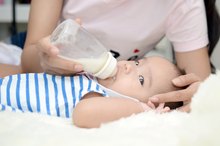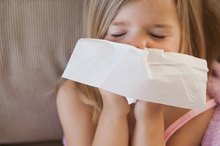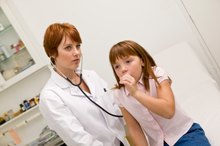How to Get Rid of Cold in 1-Month-Old Baby
If you catch a cold, there are many steps you can take to curtail your symptoms and feel better, including comfort foods, hot tea, and the use of over-the-counter cold medications. But it becomes more challenging to help a 1-month-old fight cold symptoms, when medications and chicken soup are not options. Although there is no cure for the common cold, you can take steps to help your baby feel more comfortable and reduce the risk of a more severe infection 1. If your child is premature or has a medical condition, contact his pediatrician at the first sign of a cold, to ensure his symptoms aren't related to a more serious infection 1.
Continue Breastfeeding
Newborns have immature immune systems, and their bodies are not able to fight off illnesses as well as older babies and children. If you are breastfeeding your infant, continue this practice to help support your baby's immune system. Breast milk transfers immune factors from mom to baby, to reduce the risk of infections, and also provide additional protection during illness. In fact, infection-fighting white blood cells have been shown to increase in breast milk when mom or baby has an infection. While breastfeeding may not make your baby's cold go away faster, it may reduce the risk of developing complications, such as an ear infection or pneumonia.
- Newborns have immature immune systems, and their bodies are not able to fight off illnesses as well as older babies and children.
- Breast milk transfers immune factors from mom to baby, to reduce the risk of infections, and also provide additional protection during illness.
Keep Baby Hydrated
Infant Cold & Cough Relief
Learn More
Whether your baby is nourished by breast milk or infant formula, feed him regularly to prevent dehydration. Most 1-month-old babies feed every 2 to 3 hours, but watch for cues from your infant, and feed more frequently if needed while he is recovering from a cold -- especially if he has a fever. Do not offer other fluids, such as water or electrolyte solutions, as young infants need only formula or breast milk to meet their daily fluid intake. If you are concerned your baby isn't getting enough fluids, contact his pediatrician.
- Whether your baby is nourished by breast milk or infant formula, feed him regularly to prevent dehydration.
- Most 1-month-old babies feed every 2 to 3 hours, but watch for cues from your infant, and feed more frequently if needed while he is recovering from a cold -- especially if he has a fever.
Clear Baby's Nose
In the first few months of life, infants breathe exclusively through their nose -- making nasal congestion in a 1-month-old particularly uncomfortable. Because your baby cannot blow his nose, you can ease your infant's discomfort by clearing this mucus for him. It's especially important to do this before feedings to enhance his ability to suck and swallow. Gentle use of a bulb syringe is a simple way to clear your baby's nose and make breathing easier. If the nasal mucus is thick or dry, using 1 to 2 drops of saline nose drops per nostril may help prior to using the bulb syringe.
- In the first few months of life, infants breathe exclusively through their nose -- making nasal congestion in a 1-month-old particularly uncomfortable.
- If the nasal mucus is thick or dry, using 1 to 2 drops of saline nose drops per nostril may help prior to using the bulb syringe.
Humidify
Should You Give Milk to Babies With Croup?
Learn More
Dry air can lead to discomfort by drying out nasal passages and creating thick, dry mucus. The use of a cool-mist humidifier in your infant's bedroom or nursery adds moisture to the room air, and can help keep your baby more comfortable. Clean and dry the humidifier each day to avoid infecting the room air with mold or bacteria. The use of hot water vaporizers is not recommended due to safety concerns with hot, scalding water.
- Dry air can lead to discomfort by drying out nasal passages and creating thick, dry mucus.
- The use of a cool-mist humidifier in your infant's bedroom or nursery adds moisture to the room air, and can help keep your baby more comfortable.
RSV Concerns
Sometimes infant cold symptoms are caused by the respiratory syncytial virus, also known as RSV. Most children get infected with RSV at some point, and recover without incurring a serious infection. However, premature or young infants, or children with a health condition that impacts the immune system, heart or lungs are more likely to develop a severe lung infection as a consequence of RSV.
Warnings
If your baby has cold symptoms along with fever, pale skin color, wheezing, poor appetite or decreased activity, or if you are concerned about your infant's cold symptoms, contact his pediatrician right away. Seek immediate care if your child has difficulty breathing. Cold and cough medications should not be used in children younger than 4, as they can cause serious harm. Also, fever or pain relievers should not be given to infants unless specifically approved by the child's pediatrician.
Reviewed by Kay Peck, MPH RD
- If your baby has cold symptoms along with fever, pale skin color, wheezing, poor appetite or decreased activity, or if you are concerned about your infant's cold symptoms, contact his pediatrician right away.
- Also, fever or pain relievers should not be given to infants unless specifically approved by the child's pediatrician.
Related Articles
References
- World Health Organization: Cough and Cold Remedies for the Treatment of Acute Respiratory Infections in Young Children
- Clinical and Translational Immunology: Maternal and Infant Infections Stimulate a Rapid Leukocyte Response in Breastmilk
- American Academy of Pediatrics: RSV: When It's More Than Just a Cold
- Centers for Disease Control and Prevention: Respiratory Syncytial Infection (RSV)
- American Lung Association. (2019). Facts About The Common Cold.
- Eccles R. Acute cooling of the body surface and the common cold. Rhinology. 2002 Sep;40(3):109-14.
- Johnson C, Eccles R. Acute cooling of the feet and the onset of common cold symptoms. Fam Pract. 2005 Dec;22(6):608-13.
- Fashner J, Ericson K, Werner S. Treatment of the Common Cold in Children and Adults. Am Fam Physician. 2012 Jul 15;86(2):153-59.
- AlBalawi ZH, Othman SS, Alfaleh J. Intranasal ipratropium bromide for the common cold. Cochrane Database Syst Rev. 2013 Jun 19;(6):CD008231. doi: 10.1002/14651858.CD008231.pub3
- FDA. (2018). Use Caution When Giving Cough and Cold Products to Kids.
- Poolsup N, Suthisisang C, Prathanturarug S, Asawamekin A, Chanchaereon U. Andrographis paniculata in the symptomatic treatment of uncomplicated upper respiratory tract infection: systematic review of randomized controlled trials. J Clin Pharm Ther. 2004 Feb;29(1):37-45.
- Lizogub VG, Riley DS, Heger M. Efficacy of a pelargonium sidoides preparation in patients with the common cold: a randomized, double blind, placebo-controlled clinical trial. Explore (NY). 2007 Nov-Dec;3(6):573-84.
- Paul IM, Beiler J, McMonagle A, Shaffer ML, Duda L, Berlin CM Jr. Effect of honey, dextromethorphan, and no treatment on nocturnal cough and sleep quality for coughing children and their parents. Arch Pediatr Adolesc Med. 2007 Dec;161(12):1140-6.
- Hemila H, Chalker E. Vitamin C for preventing and treating the common cold. Cochrane Database Syst Rev. 2013 Jan 31;(1):CD000980. doi:10.1002/14651858.CD000980.pub4
- Karsch-Volk M, Barrett B, Kiefer D, Bauer R, Ardjomand-Woelkart K, Linde K. Echinacea for preventing and treating the common cold. Cochrane Database Syst Rev. 2014 Feb 20;(2):CD000530. doi:10.1002/14651858.CD000530.pub3
- Sexton DJ, McClain MT. (2019). The common cold in adults: Treatment and prevention. Hirsch MS, Aronson MD, eds. UpToDate. Waltham, MA: UpToDate Inc.
Resources
Writer Bio
Sandra Ketcham has nearly two decades of experience writing and editing for major websites and magazines. Her work appears in numerous web and print publications, including "The Atlanta Journal-Constitution," "The Tampa Bay Times," Visit Florida, "USA Today," AOL's Gadling and "Kraze Magazine."









